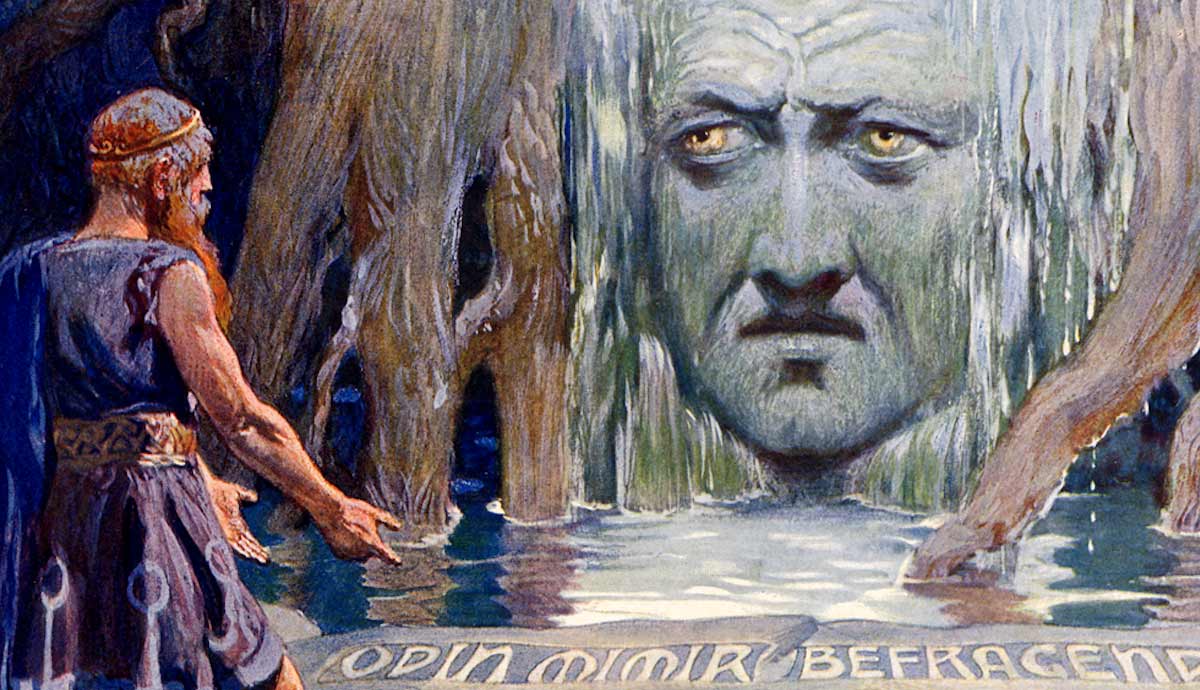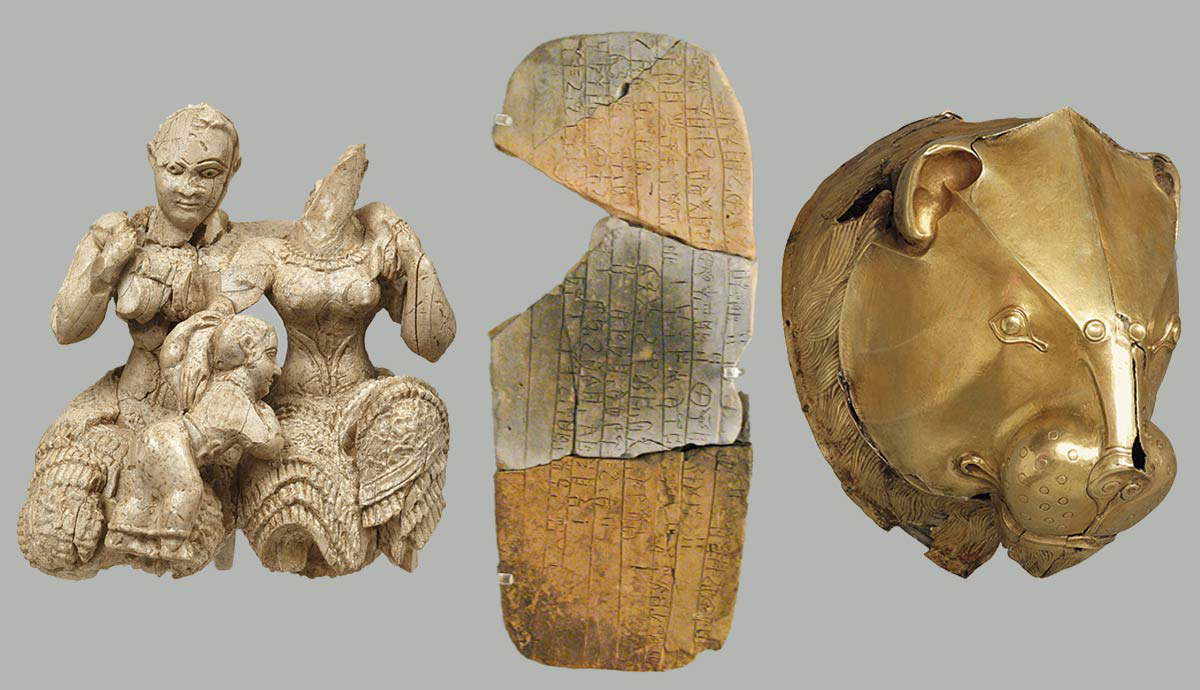
Mimir was considered the wisest being in Asgard, the realm of the gods in Norse mythology. But when he was sent to live among the Vanir gods as an advisor, they soon came to mistrust Mimir’s intelligence and killed him.
Unwilling to lose the counsel of his wisest advisor, Odin magically reanimated Mimir’s head. The spell probably required that Odin pluck out his own eye, which is why Odin is known as the one-eyed god. Odin installed Mimir’s head at the Well of Wisdom at the base of the world tree Yggdrasil so that he could consult it whenever he wished. This story is strange enough, but it also seems likely that Mimir was a giant, an ancient enemy of Asgard.
Who Was Mimir?

The word Mimir means to think, recall, or reflect in old Norse. Perfect for a god associated with wisdom and good counsel. In the early days of Norse mythological history, Mimir is described as living in Asgard alongside gods such as Odin, Thor, and Heimdall. Therefore, it is often assumed that Mimir was one of the Aesir gods. But there is also good evidence to suggest that Mimir was a giant, or Jotun, one of the ancient enemies of the gods.
At the start of time, the world was dominated by two races, the gods, all descended from the first god Buri, and the Jotun, who were all born from the first giant Ymir. This primordial giant produced asexually, with giants springing from his armpits. This meant that the giants quickly outnumbered the gods.
The gods often took giant women as wives. Odin’s mother was the giantess Bestla. But Odin and his brothers Vili and Ve were also concerned about how quickly the giant population was growing. They killed Ymir and flooded the world with his blood killing most of his giant offspring. This marked the start of long-term enmity between the gods and the giants.
A passing reference in the surviving sources suggests that Odin’s greatest teacher was the brother of Bestla, Odin’s giant mother, and therefore a giant. Most modern Norse scholars believe that this must be Mimir.
Mimir’s giant nature is seemingly confirmed by another passage in one of the surviving descriptions of Ragnarök, the prophesied Norse apocalypse that will see an army of giants invade Asgard to battle the gods. The passage says that the sons of Mimir will play while “fate burns” at Ragnarök. This suggests that the sons of Mimir will be among the creatures who wreak havoc at the end of days.
Advisor to the Gods

If Mimir is a giant, it is unexpected that he would live in Asgard. But he is not the only example. Loki is the most famous giant to have lived in Asgard. He was allowed to dwell there due to a blood brotherhood pact with Odin. The giantess Skadi was also invited to live in Asgard as part of a deal to compensate her for the death of her father.
Mimir was certainly among the gods of Asgard during the Aesir-Vanir War, a conflict between the Aesir gods of Asgard and the Vanir gods of Vanaheim. The Vanir were a different clan of gods more closely associated with nature and magic.
The war between the two clans was a stalemate and a truce was struck. As part of that truce, several Vanir gods were sent to live among the Aesir, including the goddess Freyja. In return, the Aesir sent two of their own to live among the Vanir. The charismatic god Hoenir was sent as their new leader, and Mimir the Wise was sent as his advisor.
While Hoenir was very good at delivering counsel, he relied completely on Mimir for what advice to give. The Vanir soon became suspicious of Mimir, who was constantly whispering in Hoenir’s ear. They also became disenchanted with Hoenir when they realized that he could only provide platitudes when Mimir was not around. They felt like they had been tricked by the Aesir. The Vanir eventually killed both Hoenir and Mimir. They beheaded Mimir and sent his head to Odin in Asgard.

This almost reignited the conflict between the two clans, but they decided to resolve their differences peacefully. They conducted a truce ritual that involved all the gods mixing their spittle in a common vessel. Deciding that this spittle was too valuable to waste, they used it to make the being Kvasir. He replaced Mimir as the wisest being in existence since Mimir was now dead.
Kvasir traveled the nine worlds of the Norse cosmos, teaching and sharing his knowledge. But he was soon kidnapped and killed by two dwarves who used his blood to make an enchanted drink known as the Mead of Poetry. The liquid granted the drinker complete mastery over the spoken word.
Mimir’s Head Reanimated

When Odin received the head of Mimir, he despaired. He did not want to lose the wise counsel of his uncle. A master of magic, Odin embalmed Mimir’s head so that it would not rot and took it down to the realm of Niflheim, among the roots of the great world tree Yggdrasil.
Odin placed Mimir’s head at the Well of Wisdom and magically reanimated it. The well was also called Mimisbrunnr, or Mimir’s Well, in his honor. Odin would then visit the well whenever he needed the advice of his old friend.
It is unclear how exactly this relates to the story of Odin plucking out his own eye as a sacrifice in exchange for a drink from the Well of Wisdom. This is why Odin is usually depicted with only one eye.
It seems likely that Odin may have sacrificed his eye as part of the spell to bring Mimir’s head back to life. Another source says that Mimir drinks from the well each day using a horn called Gjallarhorn, and specifically refers to the well using the kenning “Odin’s wager”. This may suggest that the well magically sustains the life in Mimir’s head and that Mimir imbues the well with wisdom.
It is also interesting that Mimir drinks from the well using Gjallarhorn, which is also the name of the horn owned by the god Heimdall. The watchman of Asgard will blow the horn to alert the gods when he sees the army of giants approaching Asgard at Ragnarök.
The myth says that at the start of Ragnarök, Odin will descend to the Well of Wisdom to seek Mimir’s advice. He may do this after Heimdall sounds the alarm. He may then take the horn with him, specifically to give Mimir water, as this seems to be part of the process of reanimating the head to seek advice.
The Knowledge of Mimir

One of the reasons why Odin did not want to lose the counsel of Mimir may have been that his uncle was one of his teachers as a young man. It is said that Bestla’s brother, presumably Mimir, taught Odin nine magical songs.
The specific spells that Odin learned from his uncle, as well as ten other spells that only Odin knows, are described in the poem Hávamál. Many of the spells relate to battle, for example, blunting weapons, stopping a spear in flight, and leading a group of warriors safely out of battle. Odin also knows a spell to heal the sick, to hush stormy seas, to repel curses, and to protect against witches. It is not clear which of these spells were taught to him by Mimir.
While surviving descriptions of the Ragnarök prophecy are very detailed, they do not record exactly what advice Mimir will give Odin on the eve of his death. Odin has already heard the prophecy of what will happen at Ragnarök from a Volva witch. This includes his own death at the hands, or rather the jaws, of the mighty wolf Fenrir, and the destruction of the world, causing it to sink back into the water of chaos. It would be interesting to know what words of wisdom Mimir had for Odin on the eve of the destruction of all things.










